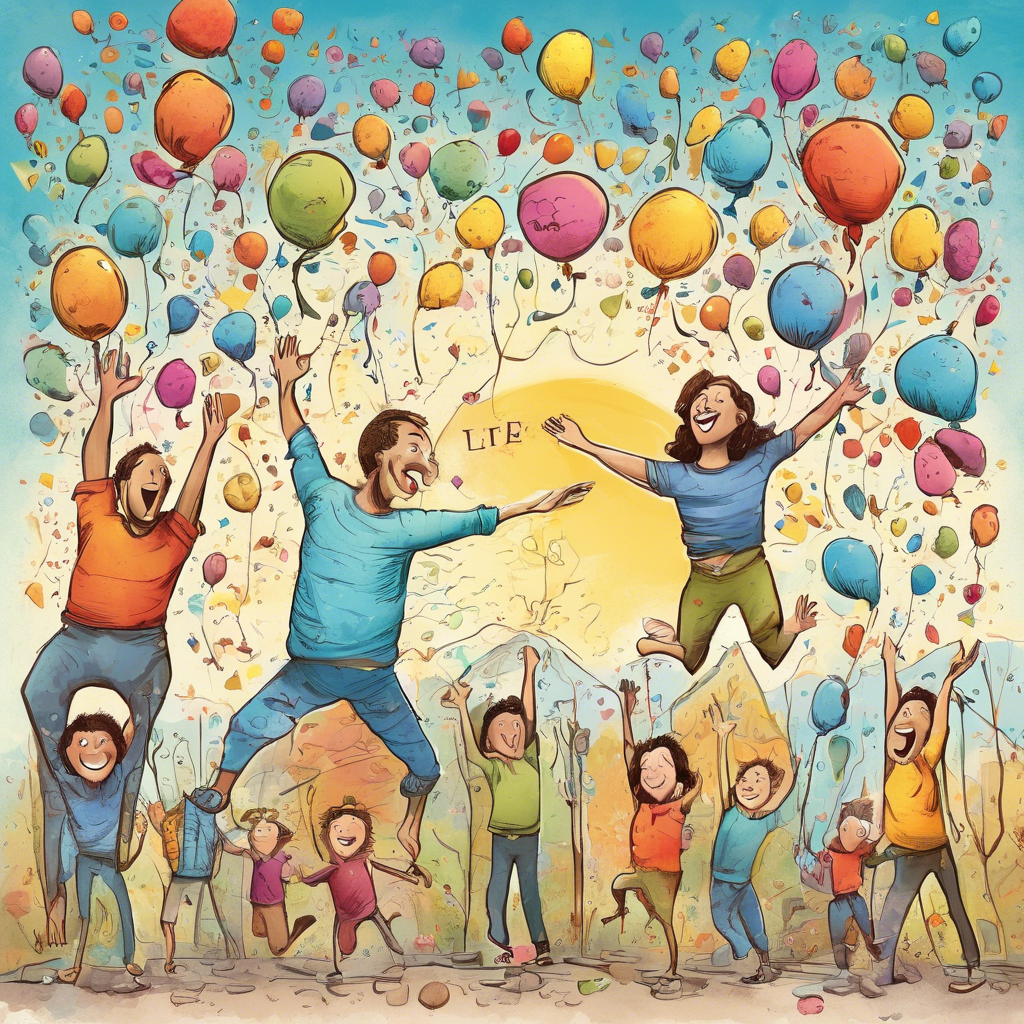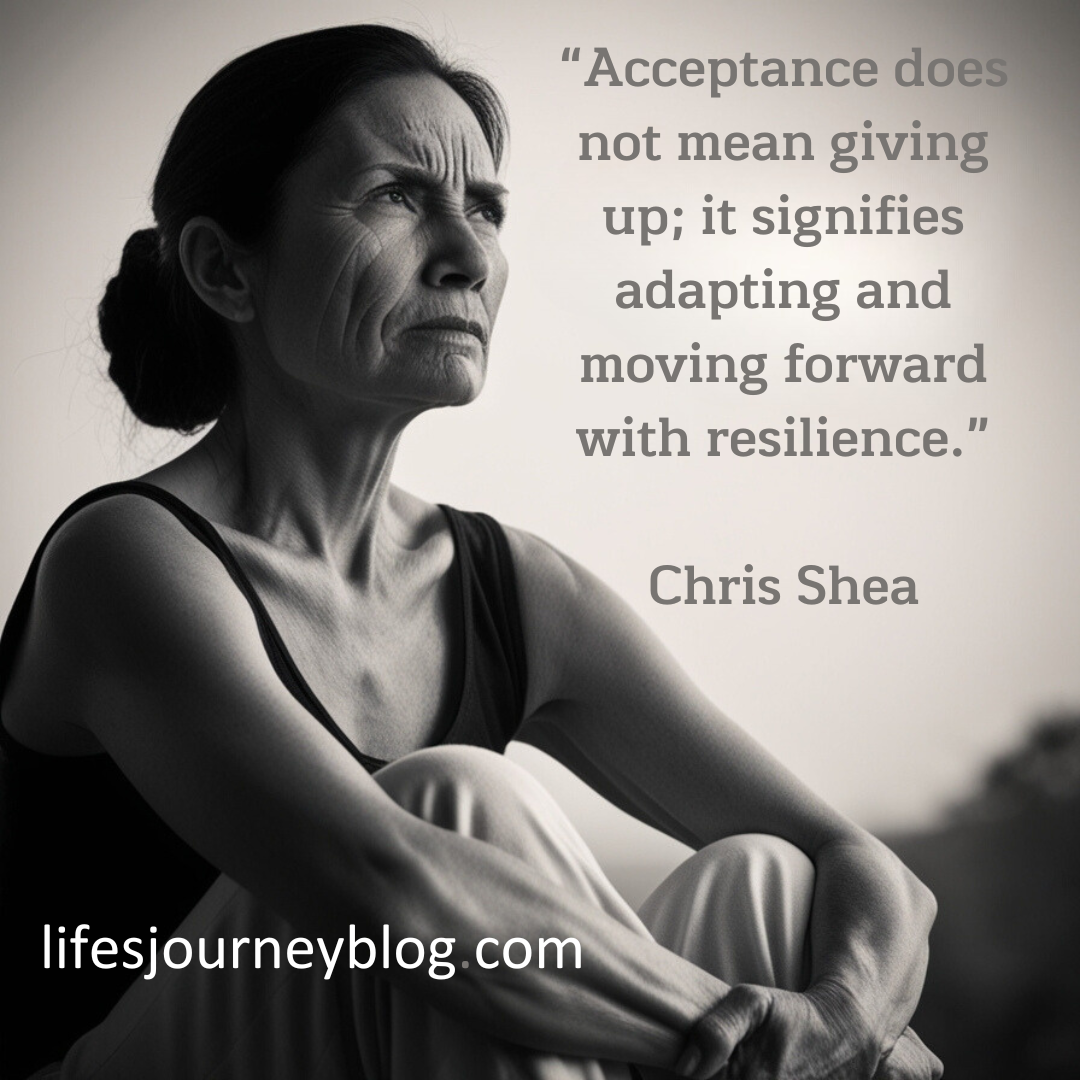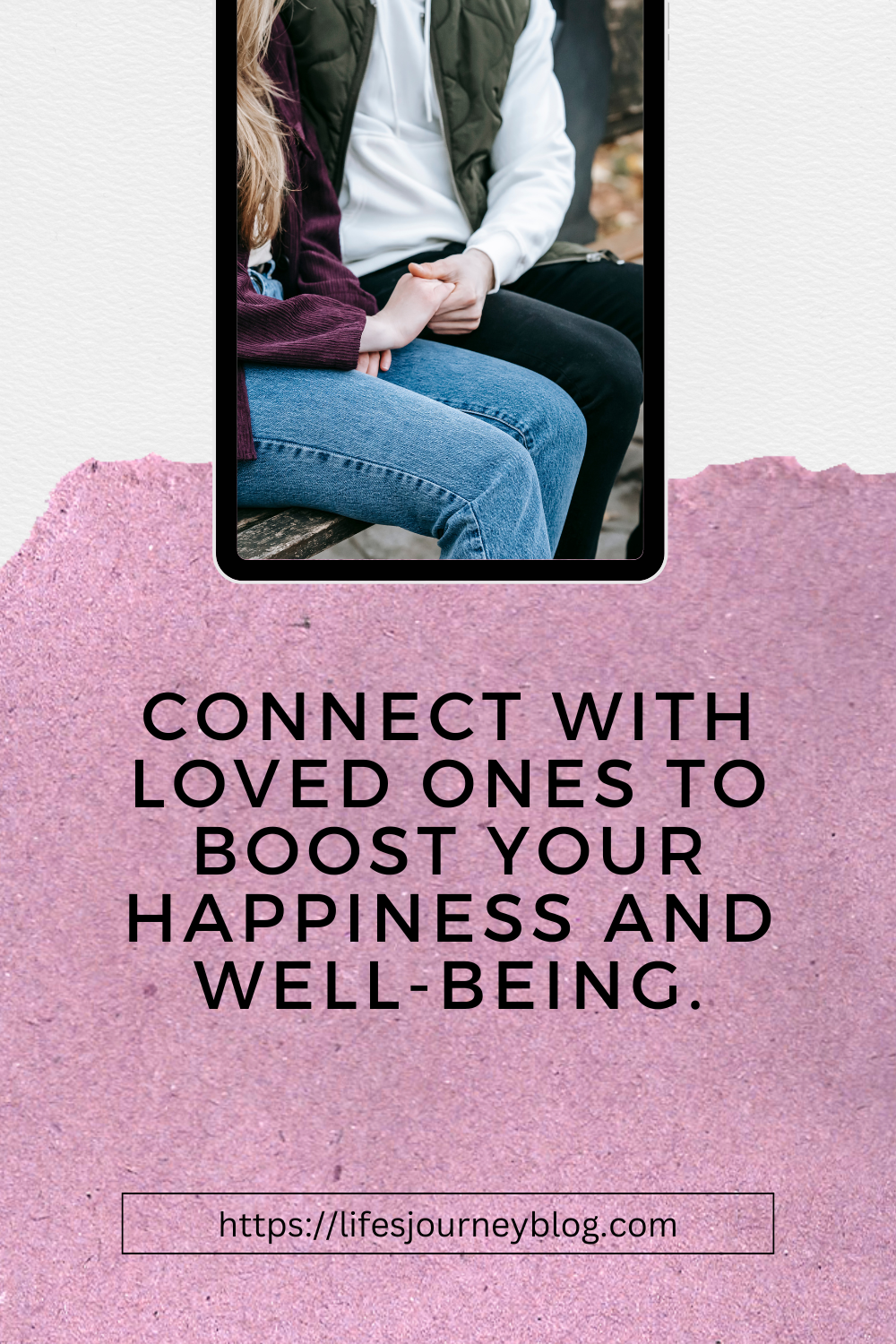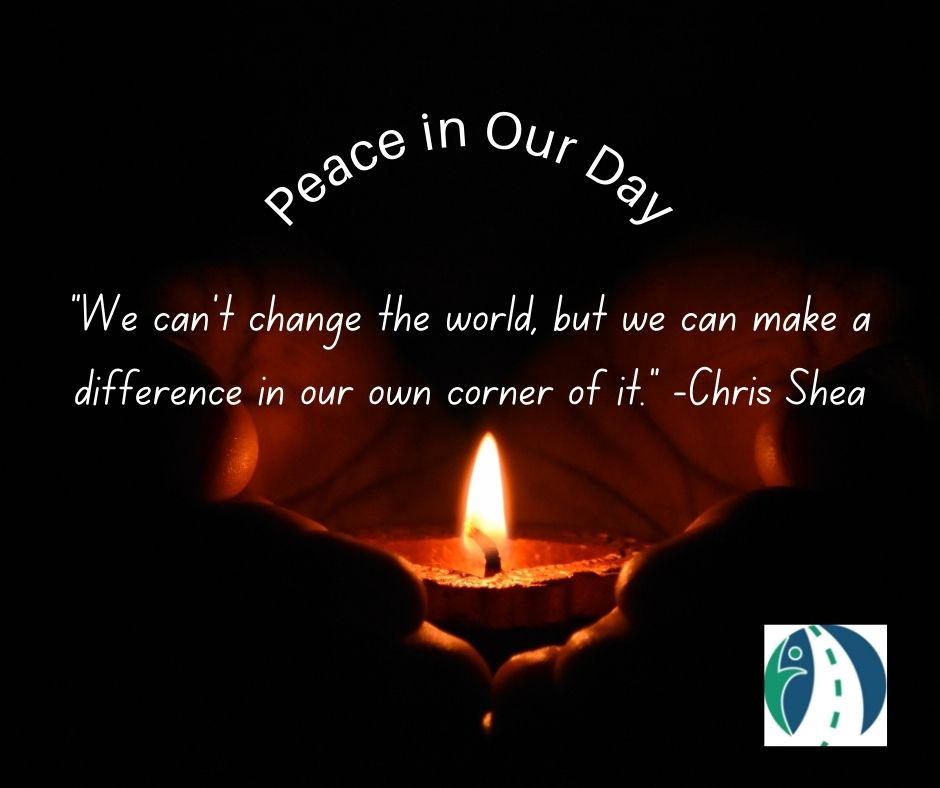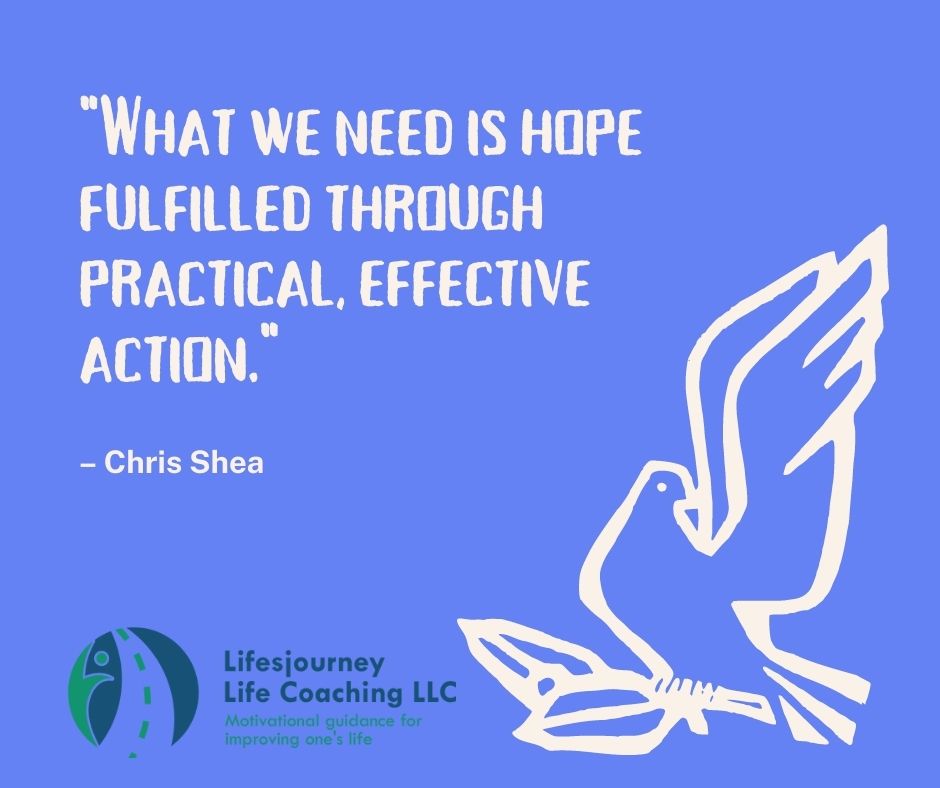Finding Inner Peace
How to Practice Mindfulness for Anxiety: Calming the Fear of the Unknown

Image Source: AI Generated
Fear of the unknown grips us all at times, so how to practice mindfulness for anxiety is an essential tool. Your mind races ahead, creating scenarios that may never happen, while precious moments of peace slip away. You’re not alone in this experience – countless people share this same struggle with anxiety.
Let me share what years of guiding others through anxiety has taught me. Mindfulness stands as one of our most powerful allies against anxious thoughts. Picture mindfulness as your trusted companion, helping you find steady ground when uncertainty shakes your world.
This guide offers more than quick fixes or positive thinking mantras. Together, we’ll explore how to build a different relationship with uncertainty – one where you can acknowledge your fears while staying anchored in calmness. Drawing from both scientific research and real client experiences, I’ll show you practical ways to face anxiety with greater confidence and inner strength.
Understanding the Mind-Anxiety Connection
Your mind holds remarkable power over anxiety. Science tells us that 301 million people worldwide grapple with anxiety – each person’s experience unique yet connected by common threads of human experience.
How anxiety affects your thought patterns
Picture your brain as a skilled fortune teller, always trying to peek into tomorrow. This natural tendency serves us well, until anxiety takes hold. Your thoughts begin to spiral into what psychologists call “cognitive distortions” – mental stories that paint pictures of worst-case scenarios and potential threats.
The role of uncertainty in triggering anxiety
Uncertainty stands at the heart of anxiety’s power. Science reveals that your brain reads unknown situations as potential threats. Much like an overprotective guardian, it sounds the alarm when faced with unpredictable circumstances. This explains those sleepless nights before important events or that knot in your stomach during times of change.
Why mindfulness works for anxiety relief
Mindfulness offers more than temporary comfort – it provides lasting relief backed by scientific evidence. Studies confirm that mindfulness-based stress reduction matches the effectiveness of traditional anxiety medications. The magic lies in two simple yet powerful skills: watching your present experiences and accepting them with gentle awareness.
Your brain actually changes through mindfulness practice. Regular sessions quiet the amygdala – your brain’s anxiety alarm system – while building stronger emotional control centers. My clients often express amazement at how these simple practices create such profound changes in their daily lives.
This connection between mind and anxiety points to something beautiful – you already possess the tools needed for peace. Mindfulness simply helps you access and strengthen these natural abilities, even when life feels most uncertain.
Rewiring Your Response to Uncertainty
Your brain holds remarkable potential for positive change. Science calls this ability neuroplasticity – think of it as your mind’s power to create new paths through difficult terrain. Research confirms that steady mindfulness practice reshapes brain regions responsible for emotional balance and memory.
Breaking the cycle of anxious thinking
Picture anxiety as a carousel – you notice worrying symptoms, question your strength to cope, then shy away from challenging situations. Yet hope shines through this pattern. Small steps toward feared situations build your confidence muscles. Each time you face uncertainty with mindfulness tools, you create stronger emotional footing. My clients often discover their inner courage through this gentle approach.
Building tolerance for discomfort
Difficult emotions resemble waves – they rise, peak, and eventually pass. Your relationship with these feelings matters more than the feelings themselves. Think of distress tolerance as emotional muscle memory – the more you practice sitting with discomfort, the stronger your ability grows to weather emotional storms without becoming overwhelmed.
Creating new neural pathways through mindfulness
Science reveals beautiful changes in your brain through mindfulness practice. Regular sessions strengthen connections in your right hippocampus, your emotional command center. My clients’ experiences mirror these findings – consistent practice builds reliable pathways toward peace. These changes run deeper than momentary relief – they represent fundamental shifts in how your brain processes fear and uncertainty.
Developing Present Moment Awareness
Picture your mind as a time-traveling explorer, constantly jumping between past regrets and future fears. Yet peace lives in the present moment. My clients discover that true presence melts away layers of anxiety and old hurts.
Shifting focus from future worries to now
Worry tricks us into missing the life unfolding right now. Try greeting your anxious thoughts like old acquaintances: “Hello there, worried mind”. Science confirms this simple truth – people feel happier when fully present, regardless of their activity.
Recognizing thought patterns without judgment
Your thoughts flow like a river – constant yet ever-changing. Let me share proven mindfulness techniques that help my clients find steadier ground:
- Feel your breath and body sensations
- Watch thoughts drift like passing clouds
- Observe your mind without fixing anything
- Guide attention back with gentle patience
Cultivating acceptance of uncertainty
Life opens beautiful doors when you welcome uncertainty. Rather than asking “Why me?”, explore “What possibilities exist?”. My clients discover a wonderful mental flexibility through this approach – their minds learn to bend rather than break under pressure.
These simple practices create what mindfulness pioneer Jon Kabat-Zinn calls “living your full life”. Each moment of presence offers a choice beyond fight or flight – an invitation to genuine contentment and inner peace.
Building a Sustainable Mindfulness Practice
Picture mindfulness as a garden – it flourishes with gentle, consistent care. My years of guiding others reveal that lasting success blooms when mindfulness feels natural, like breathing, rather than another checkbox on your daily list.
Creating a personalized mindfulness routine
Start small – simple practices woven into everyday moments work best. Morning light often provides perfect moments for practice, before life’s demands begin calling. Your commitment grows stronger roots over time – research shows that six months of steady practice helps these skills become second nature.
Overcoming common practice obstacles
Doubt, restlessness, and sleepiness visit every mindfulness journey. Take heart – studies confirm that mindfulness-based stress reduction matches anxiety medications in effectiveness. Each challenge offers seeds of growth. When sleepiness clouds your practice, try sitting taller or choosing different practice times.
Measuring your progress and adjusting
True progress shows in life’s small moments – a calmer response here, a clearer mind there. Science supports these subtle shifts, showing improvements across mind, body, and emotional well-being. Keep a simple journal of your journey, noting changes in your daily life and relationships. Remember this encouraging truth – just 13 minutes of daily practice over 6-8 weeks can create meaningful change.
Conclusion
Your journey with mindfulness opens doorways to peace, even when uncertainty feels overwhelming. Science and experience unite in showing us something remarkable – your brain actually rewires itself through mindfulness practice, building natural defenses against anxiety’s pull.
Think of mindfulness as learning a new language – the language of peace with uncertainty. Each practice session strengthens your ability to stay steady amid life’s storms. My clients often share how this simple practice brings unexpected gifts – moments of joy and clarity where worry once lived.
Your mindfulness journey deserves patience and gentle care. Small steps lead to lasting change. Many people find their path grows stronger when combining personal practice with professional support. My door stands open if you seek guidance along this path toward inner peace.
Mindfulness holds special beauty in its simplicity. Whether anxiety whispers or shouts in your life, these practices offer steady ground beneath your feet. Remember this truth – peace doesn’t come from controlling tomorrow’s uncertainties. It blooms naturally when you embrace this present moment, exactly as it is.
Barriers to Happiness: A Step-by-Step Guide to Overcome Them

Image Source: AI Generated
Everyone wants to be happy, but life throws obstacles that might seem impossible to overcome and act as barriers to happiness. Our work with thousands of people shows these challenges are manageable with the right mindset and approach.
Life can feel overwhelming when you deal with anxiety, depression, and other happiness blockers. This guide shows you practical ways to spot and tackle these barriers that help build lasting joy and fulfillment. We’ll look at proven strategies to handle both external pressures and internal challenges that have helped many people revolutionize their lives.
Understanding the Nature of Happiness
Our experience to understand happiness shows that true happiness extends beyond fleeting moments of joy. Research shows that we characterized happiness as a state of contentment and satisfaction occurring only in conditions of safety. True happiness is substantially different from temporary pleasure and represents a mindset that doesn’t depend on external circumstances.
Defining true happiness
Happiness encompasses both emotional and cognitive components in our current understanding. Research shows that specific neurotransmitters arbitrate happiness, including acetylcholine and the parasympathetic nervous system. Satisfaction and contentment describe happiness more accurately than pleasure. Our client work shows that true happiness can exist even without pleasure from dopamine, highlighting its unique qualities. As I’ve previously written, true happiness is also called inner peace.
Dispelling common myths about happiness
Research has uncovered several persistent myths about happiness that prevent people from achieving it. The World Happiness Survey shows how many popular beliefs about happiness miss the mark. These myths need our attention:
- The belief that money guarantees happiness doesn’t hold up. Research shows that higher income guides to minimal happiness gains beyond a certain point
- Many think a relationship is essential for happiness. However, research proves that single people experience the same happiness levels as married individuals
- Most people believe happiness fades with age. The truth shows the opposite – people actually become happier as they grow older
The role of mindset in achieving happiness
Your mindset plays a significant role in determining happiness levels. Research shows a strong connection between mindset and happiness. Self-awareness demonstrates the strongest link to happiness among mindset skills. A strong sense of identity and self-confidence helps promote happiness.
Mindsets can change and adapt easily. Understanding and adjusting your mindset improves well-being and builds resilience against life’s challenges. A growth mindset helps you view setbacks as opportunities to learn instead of failures. This fundamental change in perspective makes a real difference in how you handle difficulties.
Overcoming External Barriers to Happiness
External barriers create most important challenges in the interests of happiness. People can manage these common obstacles with proper understanding and the right approach.
Dealing with societal pressures and expectations
Our client work over the years reveals society’s pressure that substantially influences behavior and mental well-being. Studies show that over 72% of young adults report feeling pressured to conform to societal expectations. Social media platforms create unrealistic standards for personal success and happiness. People should develop a strong sense of self and learn to value their authenticity over society’s expectations.
Managing work-life balance
Our connected world makes balancing work and personal life a real challenge. Research indicates that employees with full autonomy to choose their work environment report higher job satisfaction. Here are proven strategies that help create a healthy balance:
- Set firm boundaries between professional and personal time
- Design your schedule around your life priorities
- Take care of yourself and manage stress regularly
Navigating financial stress and insecurity
Financial stress stands as one of the biggest external barriers that block our path to happiness. Research reveals that over 70% of Americans experience stress about money. Money-related worries affect our sleep quality, self-esteem, and relationships deeply. People need to tackle these concerns head-on instead of avoiding them. A clear financial plan helps, and support from others proves valuable because financial stress and mental health challenges tend to feed off each other.
Our experience shows that these external barriers might look daunting but we can overcome them. People can reduce these barriers’ effect on their happiness and well-being by acknowledging their challenges and taking focused steps to address them.
Addressing Internal Obstacles to Joy
Personal battles within ourselves create the toughest roadblocks to happiness and affect our personal and professional lives. Our client work shows that these inner roadblocks affect well-being by a lot. Research proves that low self-esteem often plays a major role in both anxiety and depression.
Confronting self-doubt and insecurity
Self-doubt can crush your personal growth. Research shows that low self-esteem triggers anxiety, depression, and chronic stress. These feelings often push you toward self-defeating behaviors like avoidance and procrastination. Your relationships and career progress suffer as a result. We use Cognitive Behavioral Therapy (CBT) and mindfulness to equip you with tools that challenge these negative thought patterns. Most people see the most important improvements within 12 sessions.
Overcoming past traumas and negative experiences
Past traumas create deep psychological wounds that continue to affect daily life well beyond the actual event. Research demonstrates that childhood insecurities often persist into adulthood when left unaddressed. The healing journey needs a comprehensive strategy that includes:
- Mindfulness practices to stay present
- Problem-solving therapy for proactive solutions
- Exposure work to confront, process and heal fears
Letting go of comparisons and envy
Research has found that social comparisons can poison our happiness. Studies reveal that comparisons are always unfair because we tend to match our worst traits against someone else’s highlight reel. Our clients learn that these comparisons steal precious time – each of our 86,400 seconds daily holds too much value to waste on comparing ourselves to others.
Our coaching approach helps people see their unique gifts, talents, and contributions. Personal growth, not comparison, guides us toward lasting happiness and fulfillment. This new view lets us celebrate our achievements and appreciate others’ successes without feeling less worthy.
Implementing Daily Practices for Lasting Happiness
Scientific research shows that daily happiness practices change our brain’s structure and function permanently. Scientists found that people who actively develop gratitude demonstrate greater neural sensitivity in the medial prefrontal cortex, which controls learning and decision-making.
Establishing a gratitude routine
Our experience with clients shows that gratitude practices don’t need complex routines or expensive retreats. Research proves that spending just two minutes daily scanning for three new things to be grateful for can substantially affect happiness levels. We recommend these simple yet powerful practices to our clients:
- Morning gratitude reflection (10 minutes)
- Mindful appreciation during meals
- Evening gratitude journaling
- Weekly gratitude sharing with loved ones
Incorporating mindfulness and meditation
Mindfulness practices help people reduce their stress levels and manage emotions better. Daily meditation sessions of just 10 minutes improve overall wellbeing. People who meditate for 20 minutes or longer experience even greater benefits. Mindfulness makes us conscious about directing our attention and builds a strong foundation for lasting happiness.
Pursuing personal growth and self-improvement
Our experience shows how personal development creates lasting happiness. Personal growth happens naturally as you step outside your comfort zone and explore new interests. This journey guides you to become a more well-rounded individual. Reading improves personal development and helps you learn about psychological realities.
Science confirms that happiness extends beyond feeling good. The real joy comes from working toward our full potential. Research proves that a positive mindset increases intelligence and triples creativity. Your productive energy rises by 31% too intelligence rises and creativity triples, while productive energy increases by 31%. These techniques have helped countless people break through their happiness barriers and build lasting joy in their lives.
Conclusion
Research and real-world evidence show that happiness comes from changing our mindset and taking thoughtful action. True contentment doesn’t depend on quick pleasures or achievements. It emerges when we tackle both inner and outer challenges with proven methods. Simple techniques like practicing gratitude and mindfulness help people overcome common challenges such as self-doubt, social pressure, and emotional scars.
People who practice happiness techniques every day experience positive brain changes that last. Their improved mental patterns and personal development create stronger defenses against life’s difficulties. These changes help them stay content longer.
Our coaches, who have a lot of experience, understand these patterns and can help you start your path to long-term happiness. Anyone can learn these vital skills with practice and the right guidance to find genuine, lasting joy.
Finding Spiritual Hope: A Path to Inner Peace

Image Source: AI Generated
In our fast-paced world, many of us find ourselves searching for meaning and purpose. Finding spiritual hope offers a beacon of light, guiding us towards inner peace and resilience in the face of life’s challenges. We believe that by exploring this profound concept, we can unlock a wellspring of strength and comfort that resides within each of us. A few years ago, I wrote on the topic of finding hope in life. This post shares what I’ve learned since.
We’ll dive into the nature of spiritual hope and its transformative power. Our journey will take us through various spiritual traditions, offering insights to enrich our understanding. We’ll also share practical tools to cultivate this hope in our daily lives. Finally, we’ll explore how embracing spiritual hope can have a positive impact on our relationships and communities, creating a ripple effect of positivity and empowerment.
The Nature of Spiritual Hope
Spiritual hope is a powerful force that goes beyond mere wishful thinking. It’s a deep-seated belief in something greater than ourselves, rooted in faith and the expectation of positive outcomes. Unlike fleeting desires or temporary wishes, spiritual hope has a transformative impact on our lives, shaping our thoughts, actions, and overall well-being.
Distinguishing spiritual hope from wishful thinking
Spiritual hope differs significantly from wishful thinking. While wishful thinking is often based on little evidence and serves mainly to make us feel better temporarily, spiritual hope is grounded in a firm foundation of faith and trust in a higher power. It’s not about crossing our fingers and hoping for the best; it’s about having a confident expectation of good things to come.
This type of hope is deeply rooted in our spiritual beliefs and practices. It’s not just a fleeting emotion but a state of being that influences how we perceive and interact with the world around us. Spiritual hope gives us the strength to face challenges head-on, knowing that there’s a greater purpose at work in our lives.
The role of faith in nurturing hope
Faith plays a crucial role in cultivating and sustaining spiritual hope. It’s the bedrock upon which hope is built, providing the assurance that what we hope for will come to pass. Faith and hope are intricately connected, working together to shape our spiritual journey.
When we have faith, we’re able to hold onto hope even in the face of adversity. It’s this unwavering belief that allows us to see beyond our current circumstances and trust in a better future. Faith gives us the courage to keep hoping, even when things seem bleak or uncertain.
Developing a strong faith requires consistent spiritual practices. These might include prayer, meditation, studying sacred texts, or engaging in acts of service. By nurturing our faith, we’re also nurturing our capacity for hope, creating a positive cycle that strengthens our spiritual resilience.
Hope as a transformative force
Spiritual hope has the power to transform our lives in profound ways. It’s not just about feeling good; it’s about experiencing a fundamental shift in our perspective and approach to life. When we embrace spiritual hope, we open ourselves up to new possibilities and opportunities for growth.
This transformative power of hope can have a ripple effect on various aspects of our lives. It can improve our mental and emotional well-being, enhance our relationships, and even impact our physical health. By maintaining a hopeful outlook, we’re better equipped to handle stress, overcome obstacles, and find meaning in our experiences.
Moreover, spiritual hope can be a catalyst for positive change in our communities and the world at large. When we hold onto hope, we’re more likely to take action towards creating the change we want to see. This hope-inspired action can lead to meaningful improvements in our own lives and the lives of those around us.
In essence, spiritual hope is a dynamic and powerful force that can shape our reality. By distinguishing it from mere wishful thinking, nurturing it through faith, and recognizing its transformative potential, we can harness the power of spiritual hope to lead more fulfilling and purposeful lives.
Exploring Different Spiritual Traditions
In our quest for spiritual hope, we find a rich tapestry of wisdom across various traditions. Each offers unique perspectives on finding inner peace and resilience in the face of life’s challenges.
Eastern philosophies on inner peace
Eastern philosophies have long emphasized the importance of emptiness and non-attachment in achieving inner peace. In many Eastern religions, emptiness is associated with meditation rather than negativity. The Buddhist concept of Śūnyatā teaches that all things are devoid of intrinsic meaning, encouraging practitioners to let go of attachments and find peace in the present moment.
Taoism also highlights the value of emptiness. As Lao Tzu wrote, “We shape clay into a pot, but it is the emptiness inside that holds whatever we want.” This perspective invites us to appreciate the space within ourselves and our lives, fostering a sense of hope and possibility.
Western religious perspectives on hope
Western religious traditions often view hope as a central virtue. Christian philosophers like Augustine and Thomas Aquinas analyze hope as one of the most essential virtues of a believer. They argue that hope, with its capacity to justify action beyond the bounds of knowledge, is a crucial part of rational faith.
In the Christian tradition, hope is seen as a theological virtue, alongside faith and love. It’s distinguished from mere wishful thinking by its focus on future events and its connection to what is good for the hopeful person. This perspective on hope offers a powerful source of resilience and meaning in the face of life’s challenges.
Indigenous spiritual wisdom
Indigenous spiritual traditions offer a unique perspective on hope and inner peace, often rooted in a deep connection to nature and community. Many Indigenous cultures view the ecosystem as kin, fostering a sense of belonging and responsibility to the natural world.
This approach, which I call an “ethics of belonging,” involves rigorous qualitative analysis of empirical experience distilled in contemplative storytelling, ritual, and ceremonial practices. Indigenous contemplative practices introduce a relational aspect through shared ritual and ceremony, shifting the focus from an ego to an eco identity.
These traditions emphasize what I term “kin relationality” and “ecological belonging.” Kin relationality involves the qualities of interdependence and mutuality inherent in all beings, while ecological belonging is the realization of being part of the collective Earth system.
By integrating these diverse spiritual perspectives, we can cultivate a more holistic and resilient approach to finding hope and inner peace. Whether through Eastern practices of non-attachment, Western concepts of theological hope, or Indigenous wisdom of ecological belonging, these traditions offer valuable tools for navigating life’s challenges and fostering spiritual growth.
Practical Tools for Cultivating Spiritual Hope
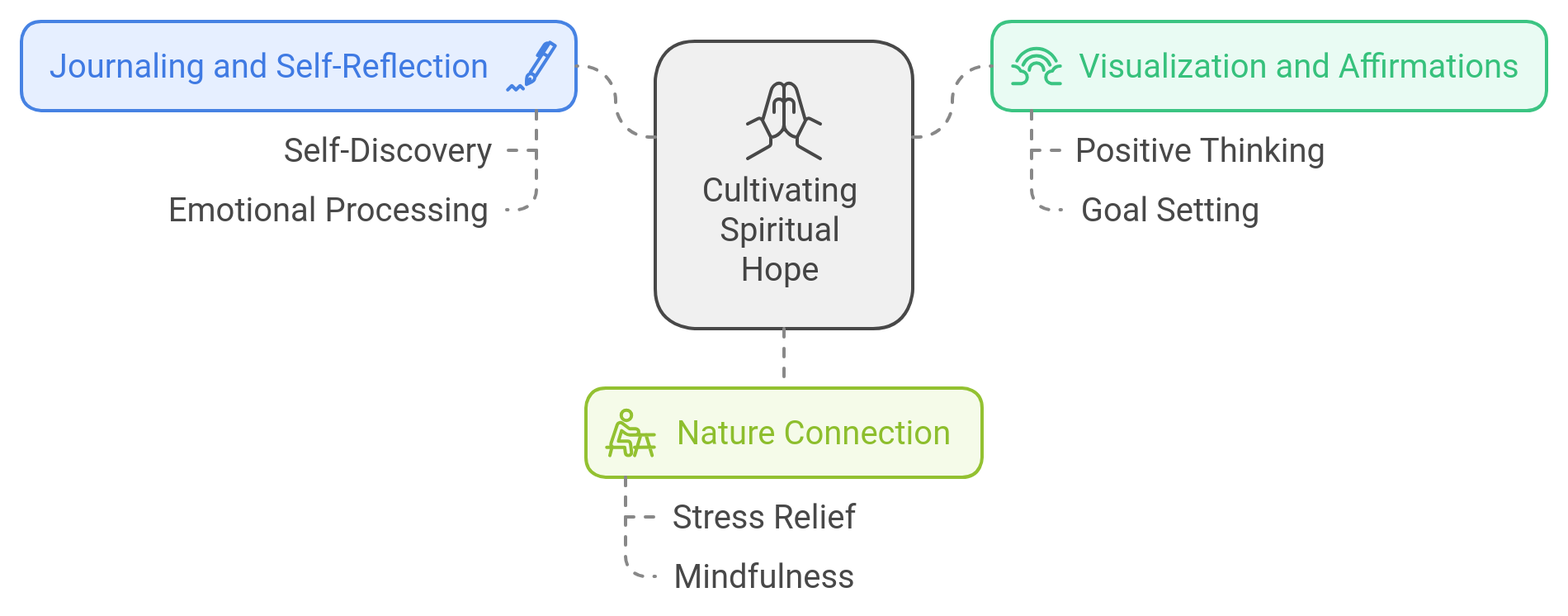
We all need ways to nurture spiritual hope in our daily lives. By incorporating simple yet powerful practices, we can strengthen our connection to the divine and find inner peace. Let’s explore some practical tools that can help us cultivate spiritual hope and resilience.
Journaling and self-reflection
One of the most effective ways to develop spiritual hope is through journaling and self-reflection. By setting aside time to write down our thoughts and feelings, we can gain clarity and perspective on our spiritual journey. Journaling allows us to declutter our minds and get a clearer view of our current state. It’s a powerful tool for self-development and spiritual growth.
When journaling, ask yourself “Why?” to get to the root of your problems. This simple exercise can be very effective in understanding your emotions and experiences. Remember, the goal isn’t to write your entire life story but to begin where you are and work to develop a consistent habit over the next few weeks.
Self-reflection breeds inner peace. It’s the stepping stone to improving as an individual. Through understanding and being humble with oneself, we obtain inner peace and the resilience to get through hard times. Take time to reflect on your thoughts, emotions, and behaviors without judgment or criticism.
Visualization and affirmations
Visualization and affirmations are powerful tools for cultivating spiritual hope. By using our imagination, we can enhance our perception of God’s presence and strengthen our faith. For example, when praying for a sick friend, try to imagine Jesus sitting next to them and comforting them. This practice can help us feel more connected to our spiritual beliefs and increase our sense of hope.
Affirmations are short, powerful, and simple positive statements that can help us overcome self-sabotaging and negative thoughts. They allow for an active meditation that can speak positive, strengthening words over the chorus of background noise in our heads. Choose affirmations that speak directly to your fears or concerns. For instance, you might say, “I am grateful for my body and what it can do” or “My thoughts are peaceful and calm.”
Nature connection and eco-spirituality
Connecting with nature is a profound way to cultivate spiritual hope. When we spend time in the natural world, we often feel more drawn to things that support life rather than break it down. Nature helps us feel more connected to our own spirit and soul, and to the universe itself.
Eco-spirituality recognizes the deep connection between spirituality and the environment. It brings together religion and environmental activism, framing the environment as a sacred entity in need of protection. By engaging with nature, we can quiet our minds, find grounding, and tap into our intuition.
To connect with nature, try going on a mindful walk or hike, meditating while sitting outside in a quiet place, or tending to a garden. If you live in a city, bring nature inside by starting a collection of indoor plants or getting fresh flowers regularly.
By incorporating these practical tools into our daily lives, we can cultivate spiritual hope and find greater resilience in the face of life’s challenges. Remember, the journey to spiritual growth is personal, so choose the practices that resonate most with you and make them a consistent part of your routine.
The Ripple Effect of Spiritual Hope
Spiritual hope has a profound impact that extends far beyond our individual lives. As we cultivate this deep-seated belief in something greater than ourselves, we begin to see transformative changes that ripple outward, touching our relationships and even our communities.
Personal transformation
When we embrace spiritual hope, we open ourselves up to a journey of personal growth and transformation. This hope acts as a catalyst, inspiring us to look beyond our current circumstances and envision a more positive future. As we develop this hopeful perspective, we often find ourselves more resilient in the face of life’s challenges.
Spiritual practices play a crucial role in this transformation. Through activities like journaling, self-reflection, and visualization, we can nurture our spiritual hope and strengthen our connection to the divine. These practices help us gain clarity and perspective on our spiritual journey, fostering inner peace and resilience.
Positive impact on relationships
The transformative power of spiritual hope doesn’t stop with personal growth; it naturally flows into our relationships with others. As we develop a more hopeful outlook, we often find ourselves better equipped to handle interpersonal challenges and conflicts.
Spiritual hope encourages us to approach our relationships with compassion, empathy, and understanding. It helps us see beyond surface-level differences and connect with others on a deeper, more meaningful level. This shift in perspective can lead to stronger, more fulfilling relationships with family, friends, and even strangers.
Moreover, spiritual hope can inspire us to be more forgiving and patient in our interactions with others. By recognizing the potential for growth and change in ourselves, we become more open to seeing that same potential in those around us.
Contributing to societal healing
The ripple effect of spiritual hope extends even further, contributing to healing and positive change in our wider communities. When individuals cultivate spiritual hope, they often feel more empowered to make a difference in the world around them.
This hope-inspired action can take many forms, from volunteering and community service to advocating for social justice and environmental stewardship. By acting on our spiritual hope, we become agents of positive change, inspiring others and creating a ripple effect of hope throughout our communities.
Furthermore, spiritual hope can help bridge divides and foster understanding between different groups. By recognizing our shared humanity and the interconnectedness of all beings, we can work towards creating more inclusive, compassionate societies.
Conclusion
The journey to finding spiritual hope is a transformative experience that has a profound impact on our lives and the world around us. By exploring various spiritual traditions, implementing practical tools, and embracing the power of hope, we open ourselves up to a deeper sense of peace and purpose. This inner transformation ripples outward, positively affecting our relationships and contributing to the healing of our communities.
As we continue to nurture our spiritual hope, we become beacons of light in a sometimes dark world. This journey is ongoing, and there’s always room to grow and learn.
To deepen your exploration of spiritual hope and its transformative power, consider booking a session with a Lifesjourney life coach. Remember, the path to inner peace and hope is unique for each of us, but by staying open and committed to our spiritual growth, we can create a more compassionate and hopeful world for all.
Finding Peace Amidst Chronic Pain: A Personal Journey of Acceptance and Resilience
Editor’s Note: This article outlines the author’s personal experience with chronic pain, a condition affecting millions globally. The author emphasizes that accepting the reality of chronic pain is the first step towards finding peace. This process mirrors the stages of grief and requires redefining self-image and adjusting expectations. The journey to finding peace with chronic pain is personal, ongoing, and demands patience. It involves developing a spiritual practice while setting realistic goals. Check out the author’s previous article “How I Cope With Chronic Pain Management Using Mindfulness” from 2019.
Introduction
Living with chronic pain is a challenging journey that affects millions of people worldwide. It’s a persistent companion that can overshadow daily life, making even the simplest tasks seem insurmountable. I empathize since I too cope with chronic pain on a daily basis. Over the years, as my pain has increased, so too has my need to cope with it. The pain will get worse; there is no cure. Therefore, the options are to cope with the chronic pain, or give in to it. I refuse to quit!
In this article, I share the techniques that work for me. We’re each different, so don’t read this article thinking I’ve covered all the ways of finding peace in chronic pain. There are many solutions.
However, I’ve learned that despite the constant discomfort, finding peace is not only possible but crucial for maintaining a fulfilling life.
Understanding Chronic Pain
Chronic pain is defined as pain that persists for more than three months, often outlasting the usual healing process. It can manifest in various forms:
- Neuropathic pain (nerve pain)
- Nociceptive pain (tissue damage)
- Idiopathic pain (unknown cause)
Common causes include:
- Arthritis
- Fibromyalgia
- Back injuries
- Migraines
The impact of chronic pain extends beyond physical discomfort, affecting emotional well-being, relationships, and overall quality of life. It’s a condition that demands a holistic approach to management and acceptance.
Accepting Your New Reality
Finding peace with chronic pain begins with acceptance. This process often mirrors the stages of grief:
- Denial
- Anger
- Bargaining
- Depression
- Acceptance
Embracing change is crucial. It involves redefining your self-image and adjusting expectations. Remember, accepting your condition doesn’t mean giving up; it means adapting and moving forward with resilience.
Practical Strategies for Pain Management
Managing chronic pain effectively often requires a multifaceted approach:
Medical Treatments
- Prescription medications
- Physical therapy
- Nerve blocks
Alternative Therapies
- Acupuncture
- Massage therapy
- Yoga
Lifestyle Modifications
Understanding and implementing ergonomic adjustments in the workplace is of paramount importance because of multiple reasons. Ergonomics is about improving workspaces so that workers can be more efficient and comfortable. Adjusting the workplace ergonomically can help employees by reducing physical stress, preventing musculoskeletal disorders. Adjusting your ergonomics at home can help to reduce your chronic pain. Consult with a medical professional to learn what furniture and tools are available for proper home ergonomics.
In the realm of health and wellness, the power of dietary modifications is often underestimated. Modifying what you eat can play a big role in managing chronic pain. The food we consume can either exacerbate or alleviate inflammation, a key component of chronic pain. Understanding the link between diet and pain allows us to select foods that can decrease inflammation and potentially alleviate chronic pain.
While the effect of diet on chronic pain varies, modifying your diet can be crucial in managing this ongoing condition. Hence, it is essential for individuals dealing with chronic pain to consider their dietary habits as part of a comprehensive pain management strategy.
Regular, light physical activity plays a pivotal role in managing and alleviating chronic pain. Engaging in consistent exercise helps strengthen muscles, improve flexibility, and enhance overall body resilience. It also aids in reducing inflammation and promoting better blood circulation, which can significantly lessen pain experiences.
In the context of chronic conditions, it’s essential to approach exercise cautiously and progressively, ensuring that the intensity matches individual health levels. Engaging in regular light exercise can effectively alleviate chronic pain, enhance quality of life, and promote better health.
Nurturing Mental Well-being
Mental health is paramount in finding peace amidst chronic pain. Consider these strategies:
- Mindfulness and meditation: Practice being present in the moment, acknowledging pain without judgment.
- Cognitive Behavioral Therapy (CBT): Learn to identify and change negative thought patterns.
- Building a support network: Surround yourself with understanding friends, family, and professionals.
Finding Joy in Small Moments
Cultivating happiness despite pain is an essential skill:
- Gratitude practices: Keep a daily journal of things you’re thankful for.
- Engaging in hobbies: Pursue activities that bring you joy, adapting them as necessary.
- Celebrating small victories: Acknowledge and appreciate even minor accomplishments.
Connecting with Others
Isolation can exacerbate the challenges of chronic pain. Combat this by:
- Joining support groups
- Participating in online communities
- Educating loved ones about your condition to foster understanding
Cultivating Inner Peace
Finding peace is an ongoing process that requires intentional effort:
Developing a Spiritual Practice
This doesn’t necessarily mean religion; it could be any practice that connects you to something greater than yourself.
Setting Realistic Goals
Break larger objectives into smaller, achievable steps to maintain motivation and a sense of progress.
Practicing Self-Compassion
Be kind to yourself. Recognize that you’re doing the best you can in challenging circumstances.
Conclusion
Living with chronic pain is undoubtedly difficult, but finding peace within this reality is possible. By using the strategies we talked about, you can create a meaningful and joyful life, even if you’re dealing with ongoing discomfort.
Remember, the journey to peace is personal and ongoing. Be patient with yourself, celebrate your progress, and never hesitate to reach out for support when needed. Your path to finding peace amidst chronic pain is a testament to your strength and resilience.
If you want to know how you can cope with your chronic pain, make an appointment with Chris. Check out his page for all the contact information.
Finding Joy in the Present Moment
Finding joy in the present moment is a profound and transformative practice that can greatly enhance our overall well-being and happiness. You may not believe this is possible, and I understand that. I too, many years ago, was skeptical until I daily put this practice into my life. In a fast-paced and constantly evolving world, where distractions abound and concerns about the future and past regrets can consume our thoughts, the idea of living in the present moment may appear challenging to grasp. However, it is a valuable skill that deserves our attention and effort to develop. By focusing on the here and now, we can find a sense of peace and fulfillment amidst the chaos of everyday life.
How do I live in the moment? To truly live in the moment, one must cultivate a heightened awareness of your present experiences, thoughts, and surroundings. This involves consciously shifting attention away from worries about the future or regrets about the past, and instead focusing on the here and now. It requires a deliberate effort to engage fully with one’s current activities, whether it’s savoring a meal, listening attentively to a friend, or simply observing the sensations of breathing. By doing so, you can reduce stress, increase your appreciation for life’s simple pleasures, and develop a deeper connection with yourself and others.
Living in the moment doesn’t mean ignoring responsibilities or planning for the future; rather, it’s about finding a balance and bringing a sense of presence and engagement to all aspects of life. With practice, one can learn to quiet the constant chatter of the mind and experience a greater sense of peace, clarity, and fulfillment in your daily experiences.
Let Go of The Past & Worries of The Future
The first step towards finding joy in the present is fully engaging with the here and now. This means letting go of regrets, worries, and preoccupations about what has already happened or might happen in the future and immersing ourselves in the beauty and simplicity of the present moment. This takes practice, patience, and time to accomplish. Trust me, this does work, but you need to put energy into this practice. By doing so, we can discover a profound sense of contentment and fulfillment that often eludes us when we are preoccupied with the past or future.
Practice Mindfulness
Practicing mindfulness is one of the keys to finding joy in the present moment. Mindfulness involves paying deliberate attention to the present moment without judgment. Observing our thoughts, sensations, and surroundings with curiosity and acceptance can cultivate a deep sense of presence. This presence allows us to savor the small pleasures of life, connect more authentically with others, and find joy in the simplest of activities.
As a life and business coach focused on guiding people toward inner peace, this topic of mindfulness is particularly relevant and important. Let me share a brief history of how mindfulness has evolved over time.
- Ancient Roots (500 BCE – 500 CE):
-
- Mindfulness has its origins in ancient Eastern spiritual traditions, particularly Buddhism.
- The concept of “sati” (mindfulness) was a key component of the Buddha’s teachings.
- Early Buddhist texts like the Satipatthana Sutta outlined mindfulness meditation practices.
- Eastern Spread (500 CE – 1800s):
-
- Mindfulness practices spread throughout Asia, evolving within various Buddhist traditions.
- Different schools of Buddhism (Zen, Theravada, Tibetan) developed their own mindfulness techniques.
- Western Introduction (Late 1800s – 1970s):
-
- Eastern philosophy and meditation practices began to gain interest in the West.
- Influential figures like D.T. Suzuki and Alan Watts introduced Zen concepts to Western audiences.
- The 1960s counterculture movement sparked wider interest in Eastern spirituality and meditation.
- Secular Adaptation (1970s – 1990s):
-
- Jon Kabat-Zinn developed Mindfulness-Based Stress Reduction (MBSR) in 1979.
- MBSR marked a significant shift, presenting mindfulness in a secular, scientific context.
- Research on mindfulness and its benefits began to grow in academic and medical communities.
- Mainstream Acceptance (1990s – Present):
-
- Mindfulness gained popularity in psychology, with the development of Mindfulness-Based Cognitive Therapy (MBCT).
- Corporations, schools, and healthcare institutions began incorporating mindfulness programs.
- Technological advancements led to the creation of mindfulness apps and online resources.
- Scientific Validation (2000s – Present):
-
- Neuroscience research has provided evidence for the benefits of mindfulness on brain structure and function.
- Studies have shown positive effects on stress reduction, emotional regulation, and overall well-being.
- Mindfulness has been integrated into various therapeutic approaches and wellness programs.
- Ongoing research continues to explore new applications and benefits of mindfulness practices.
This brief history showcases how mindfulness has evolved from ancient spiritual practices to a widely accepted and scientifically supported approach to well-being. In my personal life and as a life and business coach, I find that incorporating mindfulness techniques can be incredibly beneficial for clients seeking to enhance their personal and professional lives.
Remove Distractions
In today’s fast-paced world, we are constantly bombarded with notifications, tasks, and stimuli that distract us from the here and now. These distractions can create a sense of restlessness and prevent us from fully immersing ourselves in the present moment.
Distractions often lead to fragmented attention, making it difficult to fully engage in what we are doing. By intentionally eliminating distractions, such as turning off notifications on our devices or finding a quiet space, we can focus more intensely on the task or experience. This heightened focus allows us to appreciate the details and nuances of the present moment, leading to a deeper sense of joy and satisfaction.
Savor Moments of Beauty
Try to notice and savor moments of beauty in your daily life. Whether it’s a breathtaking sunset, a blooming flower, or a heartwarming smile from a loved one, taking the time to appreciate these moments can bring a sense of wonder and joy. Try to be fully present and engage your senses in these experiences to amplify their impact on your well-being.
Conclusion
Finding joy in the present moment is possible by practicing mindfulness. Mindfulness contributes positively to stress reduction, emotional control, and overall wellness. It’s incorporated into numerous therapeutic methods and wellness programs. Current research is investigating new uses and advantages of mindfulness practices. Eliminating distractions enables us to completely immerse ourselves in the present and appreciate finer details. Relishing beautiful moments induces feelings of awe and happiness. By adopting these strategies, finding joy in the present moment is possible, improving our capacity to experience joy in the present and foster a more satisfying life.
Let Lifesjourney guide you in strategies for your personal joy and happiness. Check out our coaching page, or call us: (240) 587-7854.
How Friendship and Deep Connections Lead to a Life of Joy
How do you define friendship? What about joy? You undoubtedly have people in your life who qualify more as acquaintances than true friends. We all do. These people are important and provide value in some way, but they are not the first people we think about when considering the deep friendships we have made. If you’re having trouble finding joy in life, check out a previous article of mine, here.
Friendship
So what is a friendship? Friendship is a relationship between people where they like and trust each other. In a friendship, people enjoy being together, sharing experiences, and helping each other with their emotions. It’s more than just knowing each other and involves a deeper connection and understanding. They are important because they give us company, support, and a feeling of fitting in.
Whether they are our friends, family members, or intimate partners, the connections we form with others are essential to our overall well-being and happiness. It is through these friendships and deep connections that we find the most fulfillment and experience true joy in life.
Joy
Friendship plays a pivotal role in our pursuit of true joy and inner peace. It is through these meaningful connections that we experience some of life’s most profound and fulfilling moments. Here are a few key ways in which friendship contributes to finding true joy:
- Emotional Support: Friends provide a support system during both good and challenging times. Knowing that someone is there to listen and understand can significantly alleviate stress and enhance overall happiness.
- Shared Experiences: Engaging in activities and celebrating milestones with friends creates lasting memories and enriches our lives. These shared experiences often become cherished moments of joy.
- Personal Growth: Friends challenge us to grow, both personally and professionally. They offer new perspectives, constructive criticism, and encouragement, which can lead to self-improvement and greater satisfaction in life.
- Sense of Belonging: Being part of a close-knit group of friends fosters a sense of belonging and acceptance. This can lead to increased self-esteem and a deeper sense of inner peace.
- Laughter and Fun: Friends often bring humor and light-heartedness into our lives. Laughter is a powerful tool for reducing stress and boosting mood, contributing to a joyful and balanced life.
In essence, friendship enrich our lives by providing emotional support, shared experiences, opportunities for growth, a sense of belonging, and moments of joy and laughter. These elements are fundamental in our journey towards true joy and inner peace.
Tips to Foster Friendship
In today’s modern era of technology, we gather “friends” on social media in quantities never before imagined! Yet we seem to be more lonely and disconnected at the same time. How can this be? I figure it’s because those “friends” on social media don’t fit the definition of friendship we stated earlier. Online virtual friendships differ from friendships with physical people outside of a screen. And it’s this difference which either leads us to joy or not.
Here are some tips for fostering deeper, more meaningful connections with the friendships that matter most to you.
Be the One Who Reaches out First
Instead of waiting for someone to contact you, reach out to them. Don’t be the person that says, “You never call!”
Reaching out can be a powerful way to strengthen your relationships. By taking the initiative to connect with important people in your life, you deepen your bond and create opportunities for meaningful conversations.
It doesn’t need to be in person. Your cell phone, equipped with text messaging and video communication capabilities, is always within reach. Leverage this technology to connect with anyone around the globe.
Listen Actively
Are you genuinely listening when you communicate with others? Next time you engage with a loved one, friend, or significant other, attempt to connect emotionally with their words. Observe their non-verbal cues to grasp the full meaning of their message. Show your attentiveness by asking thoughtful questions and reiterating key points they share to convey that they truly matter to you.
Reminisce about Wonderful Memories
Remind people of the wonderful moments you’ve shared and express gratitude for the happiness they bring to your life. By sharing joyful memories and showing appreciation, you can strengthen your connection and remind loved ones of their significance in your journey.
Meaningful relationships cause effort and dedication. Developing strong relationships with others requires active communication, understanding, compromise, and consistent support. Through this ongoing work, bonds become stronger, trust deepens, and relationships truly flourish.
In essence, cultivating and maintaining deep friendships and connections can profoundly impact our joy and overall quality of life. As a life and business coach, I encourage you to invest time and energy into building and nurturing these relationships. The rewards are immense and far-reaching, contributing to a more fulfilling and joyful life.
Boost Happiness and Well-Being with Daily Routines

Happiness is not universal; it varies from person to person. Our unique life experiences, values, and other factors shape our definitions of happiness.
A variety of factors influences our individual definitions of happiness, including our personal life experiences, values, and other unique aspects of our lives. These factors play a significant role in shaping our understanding and perception of what brings us joy and fulfillment.
Our life experiences, whether positive or negative, contribute to our understanding of happiness and inform our preferences and desires. Each person’s journey is distinct, and as a result, our understanding of happiness is deeply personal and subjective. It is through the interplay of these various factors that we develop our unique perspectives on what it means to be happy.
Regardless of the personal definition, everyone wants to be happy. Who wouldn’t prefer joy and contentment over stress and a frustrating lack of fulfillment? Here are a few routines you can practice daily to boost your emotional wellness and give you more joy.
Love Yourself Because You Deserve It
Practice self-care. Take care of yourself. Develop daily routines that make you appreciate who you are. Smile when you look in the mirror. You are the only person exactly like you that will ever exist, and that’s something to appreciate. Start embracing daily self-love practices to celebrate the unique and wonderful person you are.
Exercise for 10 Minutes
An intense 10-minute exercise session can boost your mental and physical well-being in several ways. Devote 10 minutes in the morning to physical activity with moderate to vigorous intensity. Do the same thing in the evening. You will benefit from less stress and more positive emotions because of the cocktail of feel-good hormones and chemicals that exercise produces.
Discover Your Happiness Cheat Codes
Some video games have cheat codes that help you succeed. If you can’t get past a particular level, you enter the cheat code and are victorious. You have cheat codes of happiness in your life. To discover them, record your daily experiences.
Write them down in a small notebook or on your phone. Record any event that provides you with emotions like joy and contentment. Then, turn to those experiences in the future for a reliable dose of happiness.
Start Each Day with Intention
Starting the day with intention contributes significantly to greater happiness and fulfillment. When you begin your day with purpose and clear objectives, you set a positive tone for the hours ahead. Whether setting meaningful goals, expressing gratitude, or simply visualizing a successful and harmonious day, this intentional approach helps you focus on what truly matters. It allows you to make conscious choices that align with your values and aspirations, ultimately leading to a more purposeful and satisfying life.
Practicing these emotional well-being boosters every day can lead to a significant increase in happiness and contentment. By incorporating these simple yet effective strategies into your daily routine, you are actively taking steps towards enhancing your emotional well-being and experiencing a greater sense of fulfillment and happiness in life. So why wait? Start implementing these practices today and unlock a happier, more fulfilling life filled with happiness.
We can help guide you in finding a daily pattern of happiness through life coaching. Call the office 240-587-7854 or email us: info@lifesjourneyblog.com.
Your Inner Peace Path: Essential Practices for a Calmer Mind

Inner peace, a state of serenity and calm, can be achieved through practices such as mindfulness meditation and loving-kindness meditation, which focus the mind on the present and foster feelings of love and kindness towards oneself and others. Regular physical activity, including yoga or tai chi, not only enhances mood but also contributes significantly to this tranquil state by reducing stress and increasing self-awareness.
On the journey towards achieving inner peace, one must also consider the importance of a regular sleep schedule, the nurturing of strong social connections, and the practice of gratitude, all of which play a crucial role in cultivating happiness and a sense of calm. Engaging in activities that bring joy, alongside effective time management and seeking professional help when necessary, are essential steps in navigating the path to inner peace.
Understanding Inner Peace
The Nature and Importance of Inner Peace
Inner peace is fundamentally a state where emotional and mental serenity prevails, free from disturbing thoughts, allowing individuals to control their moods and reactions effectively. It transcends mere passivity or indifference; it is an active state of profound presence and engagement with life’s challenges. This state is not exclusive to those dedicated to spiritual or religious practices; it is accessible to anyone, regardless of their lifestyle or occupation.
Misconceptions and Realities
There is a common misconception that inner peace involves disengagement from the world and ignoring personal or external issues. Contrarily, true inner peace involves a deep engagement with the world, maintaining a balance that fosters internal harmony and stability. It is about embracing life’s experiences, acknowledging and addressing suffering, not through indifference but through a mindful and balanced approach.
Inner Peace as a Tool for Life
Achieving inner peace allows individuals to cope with any event or situation, aiding in managing anxieties and fears healthily. It enhances focus, patience, tolerance, and the quality of sleep, and it significantly improves relationships and overall happiness. Techniques such as Transcendental Meditation, mindfulness, and other forms of mental and physical training like yoga and tai chi have been shown to foster this peace.
Benefits Beyond Calm
The pursuit of inner peace offers extensive benefits; it improves physical and mental health, increases emotional intelligence, and enhances one’s ability to enjoy life and maintain energy. It equips individuals with the tools to handle stress healthily and appreciate the present moment, fostering a sense of contentment and well-being that transcends ordinary happiness and situational joys.
Strategies for Achieving Inner Peace
Daily Practices for Cultivating Inner Peace
Mindfulness and Meditation Techniques
- Begin with a daily meditation routine, setting aside 10-20 minutes to focus on your breath or a specific mantra.
- Incorporate mindfulness throughout your day by engaging in activities like mindful eating, walking, or journaling to enhance present-moment awareness.
- Explore various forms of meditation such as guided, mantra, or loving-kindness to find what best suits your needs.
- Practice body scan meditation to release tension and notice bodily sensations from head to toe.
Physical and Mental Health
- Engage in at least 30 minutes of moderate physical activity most days, choosing enjoyable activities like yoga or cycling.
- Ensure a healthy diet rich in fruits, vegetables, whole grains, and lean proteins while limiting processed foods and sugar.
- Aim for 7-9 hours of sleep per night and try to maintain a consistent sleep schedule.
- Regular practice of the 4-7-8 breathing technique can help manage stress and induce relaxation.
Social and Emotional Well-being
- Spend quality time with friends and family or connect with community groups that share your interests.
- Practice gratitude daily by reflecting on what you are thankful for or maintaining a gratitude journal.
- Engage in self-compassion by treating yourself with kindness and understanding, especially during challenging times.
- Commit to regular self-reflection to gain deeper insights into your thoughts, feelings, and behaviors.
Environmental and Lifestyle Adjustments
- Reduce exposure to stressors by setting boundaries with stressful relationships and limiting social media use.
- Surround yourself with nature and elements like plants and water sounds to create a calming environment.
- Participate in creative activities to keep your mind engaged and express your artistic side.
- Practice random acts of kindness to cultivate happiness and a deeper sense of community.
These strategies, when consistently applied, can help individuals navigate their journey towards inner peace, enhancing overall well-being and happiness.
Overcoming Obstacles to Inner Peace
Internal Challenges
1. Emotional and Mental Barriers
Unresolved inner emotions such as anger, jealousy, and high self-created pressure can significantly obstruct the path to inner peace. These emotions often stem from past experiences or unrealistic expectations we set for ourselves and others. Addressing these feelings through professional help or mindfulness practices can lead to better emotional management and inner calm.
2. Psychological Factors
The need for others’ approval, fears about the future, and perfectionist tendencies are common internal factors that disrupt inner peace. These issues can lead to a constant state of dissatisfaction and anxiety, making it difficult to achieve a serene mindset.
External Challenges
1. Societal Pressures
External factors such as a fixed mindset or rigid opinions can also pose significant barriers to achieving inner peace. These often manifest as a resistance to new ideas or an inability to adapt to change, which can create internal conflict and stress.
2. Overcoming Mindfulness Challenges
To effectively overcome challenges related to mindfulness, it is crucial to start with shorter meditation sessions and gradually increase their duration. Patience, practice, and adapting techniques to fit personal needs help in building a sustainable practice. Gently redirecting attention during meditation and exploring any resistance to mindfulness can also enhance the practice.
Strategies to Overcome Obstacles
1. Non-Attachment and Reduction of Over-Caring
Practicing non-attachment and reducing the intensity of care can help manage over-caring, which is often linked to anxiety and anger management issues. By focusing less on controlling every outcome, individuals can experience a significant reduction in stress and an increase in peace.
2. Addressing Fear and Global Concerns
Fears related to global issues like nuclear war or ethical concerns such as harming living beings need to be acknowledged but also put into perspective. Focusing on actionable steps at an individual level can reduce feelings of helplessness and promote a more peaceful state of mind.
By understanding and addressing these internal and external factors, individuals can make significant strides towards achieving and maintaining inner peace, enhancing their overall well-being and happiness.
Conclusion
Embarking on the journey towards inner peace involves embracing practices like mindfulness meditation, loving-kindness meditation, and incorporating physical activity into daily routines. These strategies not only fortify mental and emotional well-being but also enhance one’s ability to navigate life’s challenges with grace and resilience. The transformative power of these practices lies in their ability to foster profound presence, increase self-awareness, and cultivate a state of serenity that strengthens one’s resolve against external pressures and internal turmoil. By consistently applying these methods, individuals genuinely embark on a path that leads to increased contentment, better relationships, and an overall sense of happiness in life.
The pursuit of inner peace is a dynamic journey that benefits immensely from guidance and support. As individuals navigate the complexities of achieving this tranquil state, it becomes essential to recognize when to seek professional assistance.
To further this endeavor, reaching out for expert advice can significantly enhance one’s journey. Call our office (240-587-7854) so we can help guide you along your path of inner peace. By embracing the techniques outlined and considering the implications of inner peace on physical and mental health, individuals can unlock a profound sense of well-being that permeates every aspect of life, thus actualizing their highest potential for peace and happiness.
How To Create A News Consumption Strategy For Mental Peace (version 2)
The Francis Scott Key Bridge Tragedy
Tragedies are an unfortunate part of human life. They have happened since humankind can remember. The difference today versus years ago is the proliferation of global data and awareness of every event everywhere in the world. Are our emotions even capable of coping with the volume of tragedies happening around the globe? Are we over loading our senses with too much tragedy?
Yesterday, March 26, 2024, a bridge spanning the Patapsco River in Baltimore City Maryland, USA collapsed after being struck by a disabled cargo vessel. The bridge, known as the Francis Scott Key Bridge, completely fell into the frigid water, taking with it a group of construction workers filling potholes on the roadway.
I mention this particular tragedy, one of many which occured on March 26 worldwide, since I spent 20 years of my adult life living in the Baltimore metro area. I’ve driven across the bridge, flown over the bridge, and even sailed under it. Those experiences don’t make me unique or special as many people can say the same. But for me, and many of those with similar experiences, this tragedy is not just a news story.
In 2022, ironically in March, I published an article entitled: “How To Create A News Consumption Strategy For Mental Peace”. In light of the Francis Scott Key Bridge tragedy I am reposting that article from 2022 below. If you’re so inclined, also check out my article “Being Hopeful For Mental Peace: Is it possible in Times of Crisis?“.
Inner peace and contentment are possible, no matter what happens in the world around us. Of course, we can’t control everything that goes on, but we can control our own reactions and how we let the news affect us.
Now more than ever, you need to stay informed about what is happening in the world. The news never stops, so you might be exposed to it constantly, whether you are watching a 24-hour news channel, receiving notifications on your phone, or scrolling through Twitter.
When you click on a shocking headline, there is always something new and scary to increase your anxiety, ramp up your stress, and inflame your anger. The toll the constant barrage of news updates has on your mental health is significant.
It is essential to stay informed, but don’t let the news consume us. Instead, find ways to stay positive and focus on the good things in our lives. For example, strengthen our relationships with the people we care about, do things we enjoy, and be kind to others.

We can’t change the world, but we can make a difference in our own corner of it. When reading a news article, take time to recall the information you just read. Write a note about what you just learned and how it is relevant to your daily life.
Yes, it is possible to have inner peace and contentment
To have inner peace and contentment, developing a personal news consumption strategy is vital. Here are a few tips to help get started:
1. Determine what is important to you and focus on the news that matters most.
2. Limit the amount of news you consume each day.
3. Be selective about the sources you rely on.
4. Take some time to reflect on the news you’ve consumed.
5. Be mindful of how the news affects your mood and emotions.
6. Make time for yourself each day, even if it’s just for a few minutes.
Developing a personal news consumption strategy can be challenging, but it’s worth it in the end. Here are some tips for developing a personal news consumption strategy:
1. Decide what news sources you want to rely on and stick to them. This will help you develop a sense of trust in the information you’re getting and make it easier to verify the accuracy of stories.
2. Set aside time each day to read/watch the news. This will help you stay informed without feeling pulled in every direction and allow you to focus on individual stories.
3. Balance your news consumption with other activities. This will help you stay informed without feeling overwhelmed or stressed.
4. Take breaks from the news. This will help you avoid getting stuck in a news cycle and allow you to come back to stories with a fresh viewpoint.
Figuring out your primary sources for news is the first step in creating a personal news consumption strategy. Once you know where to find the news you’re interested in, you can start to think about how much time you want to spend on it each day. It’s essential to be realistic about how much time you have and set boundaries.
You don’t have to consume the news in the same way everyone else does. Instead, you can develop your own strategy that works for you and helps you stay informed without feeling overwhelmed or stressed.
The goal of developing a personal news consumption strategy is to identify the most important topics to you and find the most reliable sources of information for those topics. Remember that not all sources of information are created equal. Some sources are biased, while others are simply inaccurate. Therefore, it is vital to find sources that you can trust to make informed decisions about the issues that are important to you.
Constant news exposure can have adverse effects on our mental health – it’s crucial to find a balance between staying informed and healthy. Make sure to take breaks from the news, and don’t forget to take care of yourself!
If you wish to speak with me regarding stress or anxiety from the news, contact my office at (240) 587-7854, click here to book a session.
Being Hopeful For Mental Peace: Is it possible in Times of Crisis?
How to CARE and COPE at the same time?
Mental peace is something that everyone wants. Unfortunately, it seems that we don’t always get it. In times of crisis, we tend to become anxious or depressed. What can we do to achieve mental peace?
Optimism is what I strive for in life. However, I think I end somewhere in the middle between optimism and pessimism. This middle space I call “realism”. Overall, I’m basically fine with being a realist because it keeps me grounded. The problem with being a realist, though, is that there is little space left for making changes to the events in the universe as the realist deals only with the given reality; he can’t deal with any other reality.
Optimists see potential to change things for the better, while the realist simply sees what is.
As I write this my area of the world is concerned with the effects of the coronavirus, rising inflation, supply chain issues, and record-high gas prices. Of course, most of the world’s general attention is focused on Russia and Ukraine. How that conflict will ultimately affect the rest of the world is only an educated guess. Hence our lack of mental peace as we struggle through these times of crisis.
The more I hear and read the news, the stronger is my desire to escape from it all! But there’s nowhere to go! In a previous article, I wrote about how to work on a healthy news consumption strategy, that’s a start for obtaining mental peace. Wanting to escape from these times of crisis is the realist in me talking. My sense of realism has no regard for coping with or changing my current reality, only in fleeing from the crisis so as not to have to deal with it at all.
As I continue to feel the need to flee these times of crisis, the realist in me leans more toward the pessimist as I realize, deep inside of my thoughts, that there is no escape. There is nowhere for me to physically flee, and the more I feel trapped the more anxious and stressed I become. Amidst the barrage of news and opinions, my inner struggle spirals the more I hear of despair, economic worries, and violence in our world.
The optimist in me wants to join the inner thoughts and conversation with my inner-realist. (As I previously said, I do try my best to be an optimist.) But even if the realist allows such a dialogue, what might it sound like? In light of the tensions in the world, what can my inner-optimist say without sounding either naive or like a quote from a greeting card?
How can we be realistic AND optimistic?
The optimist views the world from the mindset that every challenge can be overcome, and believes mental peace and joy always prevail, even in times of crisis. Optimism motivates us to strive to overcome even if we can’t imagine a positive outcome. Deep within our thoughts we know, without a doubt, that without at least trying, a future full of hope will never be realized.
The joint inner dialog of the optimist with the realist must take into account the difficult realities we face while avoiding naive “answers.” What we need is hope fulfilled through practical, effective action.
My inner optimist, in its desire to make a change instead of fleeing, reminds me to turn to my spiritual life. And I suggest the same for you, the reader. It doesn’t matter the nature of your religion, or the lack thereof, but what does make a mental peace shift is the knowledge and belief of something/someone greater than myself. “Religion and belief are now seen by many researchers and clinicians as an important way to cope with trauma and distress thanks to research over the last three decades.” (Source: apa.org)
A Spiritual Viewpoint
That research identified positive and negative forms of religious coping as well as evidence that how people experience and express their faith has implications for their well-being and health. “People who made more use of positive religious coping methods had better outcomes than those who struggled with God, their faith, or other people about sacred matters” (apa.org Dr. Kenneth Pargament, Ph.D., professor emeritus of psychology at Bowling Green State University)
In a compilation book of reflections written for the 9/11 attacks in the USA titled “Franciscan Voices on 9/11”, we find this quote which I use to this day:
“In despair, we give up on our relationship with God. Doubt, on the other hand, is a sign that our faith is alive and kicking; it is part of the rhythm of faith itself. Lament is not a failure of faith, but an act of faith. We cry out directly to God because deep down we know our relationship with God counts; it counts to us and it counts to God. Even if we do not experience the closeness, we believe God does care. Even if God seems not to hear, we believe God is always within shouting distance. In the Scriptures, God does not say, “Do not fear, I will take away all the pain and struggle.” Rather, we hear, “You have no need to fear since I am with you””
7 ways to help face times of crisis in the world as both an optimist AND a realist
1. Remember, you’re not alone.
The daunting task of coping with times of crisis is not ours to struggle with alone. Seek out others who feel the same as you and, instead of complaining or despairing, work together on practical local solutions to the crisis.
2. Know that you are not a victim.
A victim is a person who suffers as a result of events happening to them that they can’t control. You may say that according to that definition we are victims of what’s happening in the world. But, if we change our perspective on how we define “world”, not meaning the entire globe, rather, defining my world as consisting of my local community, we can create reasonable expectations. Creating reasonable expectations allows us to actually do something to affect change locally. For example, it is unreasonable to make our personal goal that of world peace. However, creating a peaceful home, work, or local community is a reasonable personal goal.
3. Empower yourself and others.
Educate yourself about the struggles we’re facing (from multiple sources and points of view) and solutions tried in the past. Learn what worked in the past and what didn’t work. Figure out why it didn’t work and what you can do differently now to make positive change more likely. Seek out and obtain the resources needed to carry out your goal.
Our ability to work with others to find a solution to shared problems removes the label of “victim,” replacing it with “survivor.” Although we need to educate ourselves about the issues, it’s also important to keep a balance, allowing for some news-free periods.
4. Reclaim your power.
Once we realize that we are not powerless, our desire to implement change brings about renewed strength and optimism. Recognize the power and strength that you individually have, and that we as a group have, and find creative ways of using your power for the common good.
Do not let the power itself take over. Even if we feel invincible, in reality, we won’t always make the proper decisions. Learning from our mistakes is a sign of strength, for the knowledge gained from the mistake will help you to avoid that, or similar mistakes, in the future.
5. Focus your effort and your energy.
As I previously mentioned, our power and abilities are limited, so wisely focus your time and energy on those tasks which can be completed, and not on tasks you know are impossible for you to complete. No one person, or one group, can do everything.
6. Show empathy for others.
As we learn about the issues affecting our world, we begin to realize that many of our problems originate with people not understanding each other. We tend to view the world from our own perspective and only validate our own history, failing to recognize that those with whom we may disagree also view their world from their perspective and history.
Finding solutions to problems presupposes that all parties agree on the nature of the problem. Empathy, placing ourselves in the shoes of another, provides us a deeper understanding of the concerns of others. By viewing the world through their perspective, we become better informed and thereby better prepared to find and carry out real solutions. Empathy does not mean agreeing with another’s opinion. It simply means you see their perspective as they view it.
7. Don’t forget self-care.
The realist in me recognizes that to accomplish all of this, I will end up draining and wearing myself out. But in the union of the realist with the optimist, I recognize the need for self-care. Take time for yourself; keep up bonds with your family and friends; find activities or hobbies which do not relate to the work at hand; spend time in meditation and quiet to focus yourself.
Obviously, I do not propose these steps as absolute solutions to the current times of crisis of the world. But I do offer them as guides to keep us grounded in reality and keep us hopeful and passionate enough to experience mental peace make a lasting difference.
{loadmoduleid 140}


